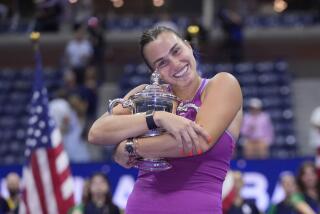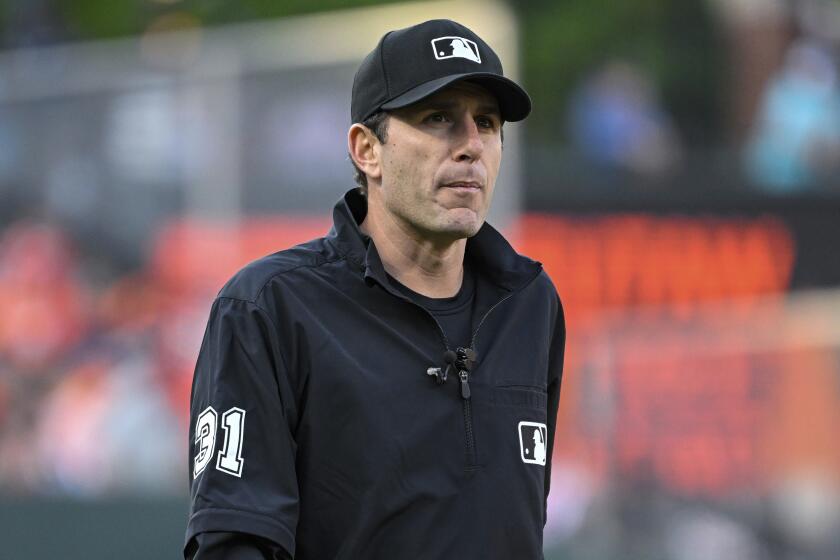TENNIS : Even Without Sampras and Rafter, the Sport Chalks Up a Net Gain
- Share via
NEW YORK — The gloom and doom hung like smog in Riverside over the National Tennis Center early in the U.S. Open. Pete Sampras and Patrick Rafter, the straws that were supposed to stir the drink in this tournament, were gone.
Since Reggie Jackson can’t play tennis, the days ahead appeared likely to be, well, not so stirring.
Those with the biggest stakes put on happy faces and soldiered on.
“You’ll still see a lot of great matches,” tournament director Jay Snyder said.
Added Gordon Beck, senior vice president of sports and production at USA network, “People still watch. They still come out. Tennis is healthy.”
Is it, really?
Can Andre Agassi, unquestionably the biggest draw in the game today, carry the male side of the sport until Sampras, perhaps the greatest player ever, and Rafter, perhaps the sexiest, heal and return?
Will the public remain titillated by the women’s side of the game, which features charisma and trash talking in Martina Hingis and the Williams sisters, and world-class nice people and great players in Lindsay Davenport and Monica Seles, but about as much depth as your 5-year-old’s backyard wading pool? The first week of almost any Grand Slam event on the women’s side is an exercise in predictability.
Can tennis find a fiscally viable niche through the maze of Super Bowls, World Cups, Final Fours and World Series that dominate the sports scene?
When Sports Illustrated posed the question in 1994 that rocked the game--”Is Tennis Dead?”--was it right then, but wrong now? Did the corpse get out of the casket?
Despite the loss of Sampras and Rafter at the worst possible time, the answer to all of the above appears to be yes.
At 8:45 a.m. last Friday, there was an Exhibit A. More than two hours before the first match, ticket windows on the side of the complex nearest the subway station were jammed. The crowd was backing up toward the boardwalk that connects Shea Stadium and the National Tennis Center. The best tickets to the prime seats in the main venue, Arthur Ashe Stadium, had long since been sold, so these were people coming on something of a whim, buying $25 grounds passes that gave them access everywhere but Arthur Ashe Stadium.
They were here to see Fredrik Jonsson play Nicolas Lapentti? Barbara Schett play Virginia Ruano Pascual?
Apparently.
Some would say that there is no accounting for taste. Others would wax poetic about the number of tennis followers in America who truly love to see good, close competition, even if it involves players about whom they know nothing.
John McEnroe touched on that on Friday’s USA telecast, after two-time Grand Slam finalist Cedric Pioline of France had struggled to get past German qualifier Lars Burgsmuller in five sets.
“There are a lot of guys out there who can really play,” McEnroe said.
The best assessment seems to be that tennis, while not an NFL gold mine or even a NASCAR oil well, is holding its own, thank you, doing well enough that wounded ducks named Sampras and Rafter aren’t bringing the whole flock down.
Numbers tell a lot.
Last year, the U.S. Open generated $64 million in revenue. This year, the projection is $77.9 million. USA, which televises weekdays, has three years left on a contract that pays the USTA $17 million. CBS’ rights fee for its weekend telecasts is $33 million.
So, the USTA will have, from this event, $127.9 million to fund its programs. Not a bad piece of change.
USA’s ratings after the first week were down 11% from last year, when they were around 1.1. They are projected at closer to 2s this week. One rating point represents about 750,000 homes, and that kind of viewership has been greeted happily in the USA studios here.
CBS’ coverage on Sunday had an overnight television household rating of 2.7, up 4% from 1997’s Sunday coverage the first week. CBS did not have tennis on Sunday of the first week last year because it was the first week of the NFL season.
On Saturday, CBS had an overnight rating of 2.5, up 25% from last year and tying for the highest-rated Saturday since 1995.
Other numbers tell a similar story. In the third year of the 22,500-seat Ashe Stadium, attendance is a series of daily spikes on a chart.
The total through Saturday was 297,788. The Ashe Stadium capacity is the measuring stick for sellouts, so the 12 session average of 24,821 means that about 2,500 grounds passes, at $25 apiece, are being sold to those willing to settle for no access to the big show in the big stadium.
Friday’s was the best day session ever, drawing 29,042, and Friday also had the best two-session day with 51,722. The best night session was Saturday’s, with 22,860. Basically, this event has a 50,000-person daily ticket handle lined up through Thursday, when the last day-night sessions are scheduled.
And those aren’t bleacher seats at Wrigley Field. The cheapest ticket was for the top row of the Ashe Stadium on the first day, $21. The most expensive was courtside for the men’s final next Sunday, $635. Many of the best tickets are in the $200-$300 range, and those have been gone for months.
Tennis stumbled through a winter and spring of discontent.
The men suffered from a series of No. 1-ranking changes brought about by losses in the first round, or by players staying home from tournaments.
The public was confused and turned off.
The Australian was won by Yevgeny Kafelnikov, a good Russian player with little perceived charisma, who then went on a two-month streak where he couldn’t beat the ball boys, but still hung around No. 1. Martina Hingis won the women’s title, then made disparaging remarks about the sexual preference of the player she beat in the final, Amelie Mauresmo of France.
This time, the public was just turned off.
On the men’s schedule, 30 players won in the first 33 events. Then Agassi got the public’s attention with a stirring victory at the French, making him one of only five men to have won all four Grand Slam events at least once.
Still, heading into Wimbledon, no top-seeded male had won a title in 1999, and until the Los Angeles event at UCLA in late July, no final had matched the first- and second-ranked players. Sampras took care of the first by performing to his No. 1 seeding at Wimbledon and a few weeks later, in a classic final in the Los Angeles Mercedes event, No. 1 Agassi played No. 2 Sampras, who won a crowd-thriller.
Not only had the pair finished the event with an incredible final, but they also had kicked it off with a Monday night charity event called Tennis at the Net that paired Sampras with Robin Williams and Agassi with Billy Crystal. It was a sold-out, warm-and-fuzzy night that made friends for the sport for years to come.
The best summer run tennis has experienced in some time had begun.
L.A. had a record attendance of 81,433, and record crowds in Montreal and Cincinnati followed. Crowds at the rest of the U.S. Open lead-in events at Washington, Indianapolis and Long Island were up from last year.
The women were doing the same kind of summer business. After popular Davenport took a feel-good title at Wimbledon, the WTA took off, starting with the Palo Alto tournament the same week as the L.A. men’s meet.
From Palo Alto on, the WTA attracted record crowds in La Costa, Manhattan Beach, Toronto and New Haven, with New Haven crowds growing by 80%. The 3-millionth fan of the season went through the turnstile there, marking the earliest point in a season for the WTA to reach that milestone.
Now, tennis ball sales are up, racket sales are up. The sport in general, as they say on Wall Street, is trending up.
Peter Bodo is the senior writer for Tennis magazine. He has seen the ups and downs for years, and has written objectively about each. For Bodo, it’s pretty simple where the sport is now.
“People seem to think it is kind of fun again,” he said. “They like it. They are interested.”
Pete and Patrick? They’ll come back, and all indications are that they’ll like what they see when they do.
More to Read
Go beyond the scoreboard
Get the latest on L.A.'s teams in the daily Sports Report newsletter.
You may occasionally receive promotional content from the Los Angeles Times.











